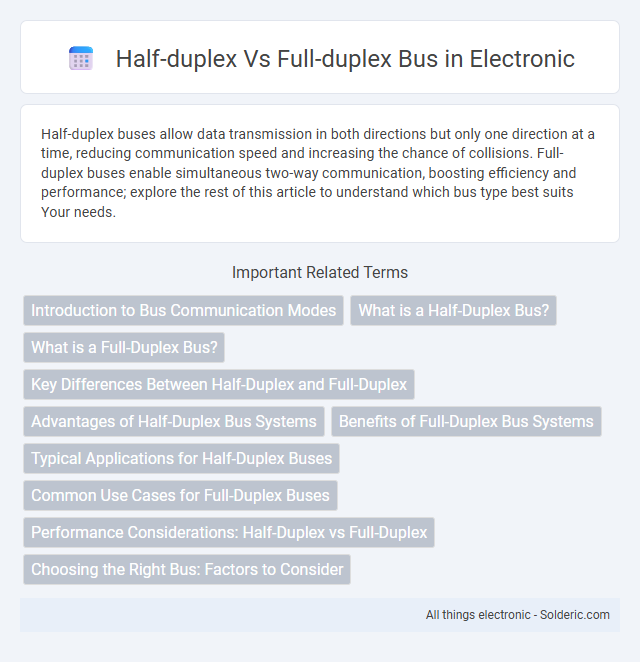Half-duplex buses allow data transmission in both directions but only one direction at a time, reducing communication speed and increasing the chance of collisions. Full-duplex buses enable simultaneous two-way communication, boosting efficiency and performance; explore the rest of this article to understand which bus type best suits Your needs.
Comparison Table
| Feature | Half-duplex Bus | Full-duplex Bus |
|---|---|---|
| Communication Mode | One direction at a time | Simultaneous both directions |
| Data Flow | Single channel for send and receive | Separate channels for send and receive |
| Speed | Lower effective throughput | Higher effective throughput |
| Complexity | Simple and inexpensive | More complex and costly |
| Use Cases | Walkie-talkies, older Ethernet (10BASE2) | Modern Ethernet (Gigabit, 10 Gigabit), telephony systems |
| Latency | Higher due to switching | Lower due to simultaneous communication |
Introduction to Bus Communication Modes
Half-duplex bus communication allows data transmission in both directions but not simultaneously, requiring devices to alternate between sending and receiving. Full-duplex bus communication supports simultaneous two-way data transfer, enhancing throughput and reducing latency. Choosing between half-duplex and full-duplex modes depends on the system's bandwidth requirements, hardware capabilities, and complexity of implementation.
What is a Half-Duplex Bus?
A half-duplex bus allows data transmission in both directions but not simultaneously, meaning communication can only occur one way at a time. This type of bus is commonly used in systems where simplicity and cost reduction are important, such as in older Ethernet standards or walkie-talkies. Your choice of a half-duplex bus can impact network efficiency due to the need for devices to take turns when transmitting data.
What is a Full-Duplex Bus?
A full-duplex bus is a communication system that allows data transmission in both directions simultaneously, enhancing network efficiency and speed. It contrasts with half-duplex buses, where data can only travel one direction at a time, causing potential delays and collisions. Full-duplex operation is crucial in modern networks such as Ethernet switches and fiber optic communications to maximize throughput and reduce latency.
Key Differences Between Half-Duplex and Full-Duplex
Half-duplex communication allows data transmission in both directions on a single channel but only one direction at a time, reducing network efficiency compared to full-duplex systems. Full-duplex buses enable simultaneous two-way data transfer, effectively doubling communication capacity and minimizing latency. Understanding these key differences helps you select the appropriate bus type for applications requiring either simple or high-speed, concurrent data exchange.
Advantages of Half-Duplex Bus Systems
Half-duplex bus systems offer the advantage of simpler hardware design, reducing complexity and cost compared to full-duplex systems. They require fewer transmission lines, which minimizes wiring and conserves physical space in your network setup. This efficiency makes half-duplex buses ideal for applications where bidirectional communication is necessary but simultaneous data transfer is not critical.
Benefits of Full-Duplex Bus Systems
Full-duplex bus systems enable simultaneous two-way data transmission, significantly increasing communication efficiency and reducing latency compared to half-duplex systems that allow data flow in only one direction at a time. This capability supports higher throughput in modern network architectures such as Ethernet and fiber-optic communication, enhancing overall system performance. Full-duplex buses also minimize collisions and retransmissions, improving reliability and enabling smoother, faster data exchange for critical applications.
Typical Applications for Half-Duplex Buses
Half-duplex buses are commonly used in communication systems where data transmission occurs in one direction at a time, such as walkie-talkies, CB radios, and some industrial control networks. These applications benefit from the simplified hardware and cost-effectiveness of half-duplex operation, making it ideal for scenarios with limited bandwidth or where simultaneous two-way communication is unnecessary. Your choice of a half-duplex bus is often influenced by the need to balance performance and efficiency in resource-constrained environments.
Common Use Cases for Full-Duplex Buses
Full-duplex buses are commonly used in high-speed network communications such as Ethernet, where simultaneous two-way data transfer is essential for reducing latency and increasing throughput. They are prevalent in modern telecommunications systems, including fiber optics and wireless networks, supporting real-time voice and video streaming with minimal delay. Data centers and server farms also employ full-duplex buses to facilitate efficient, parallel processing and high-volume data exchange between servers and storage devices.
Performance Considerations: Half-Duplex vs Full-Duplex
Full-duplex buses allow simultaneous two-way communication, effectively doubling data transfer rates compared to half-duplex systems, which transmit data in only one direction at a time. Your network performance can greatly improve with full-duplex by reducing collisions and minimizing latency, making it ideal for high-speed data environments. Half-duplex buses, however, may suffice in simpler or cost-sensitive applications where bandwidth demands are lower.
Choosing the Right Bus: Factors to Consider
Choosing the right bus involves evaluating data transfer speed, communication complexity, and application requirements. Half-duplex buses allow bidirectional communication but only one direction at a time, making them suitable for simpler or cost-sensitive systems with moderate data throughput needs. Full-duplex buses enable simultaneous two-way communication, offering higher performance and efficiency ideal for real-time data exchange or high-bandwidth applications.
Half-duplex vs Full-duplex bus Infographic

 solderic.com
solderic.com